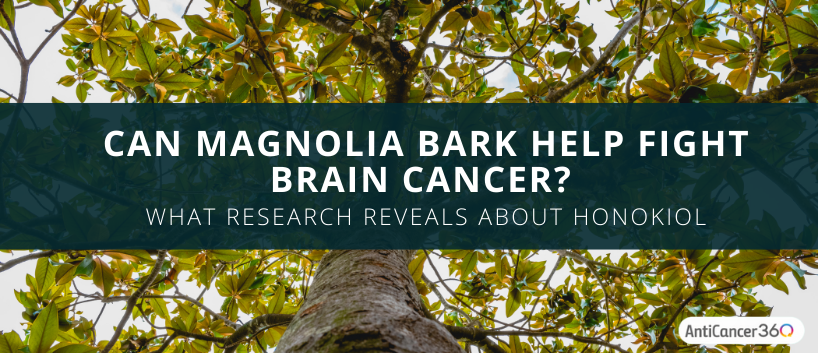Magnolia trees are known for their dark green leaves and aromatic white or pink flowers. Beyond their beauty, the medicinal benefits of magnolia bark and flowers have been used for thousands of years in traditional Chinese medicine [1]. One of the most bioactive magnolia compounds that’s been studied for its numerous health benefits, including potential anticancer effects, is honokiol.
When you’re fighting cancer, it’s essential to support your body in every way possible. Adding certain natural substances to your treatment plan may be a valuable strategy to consider.
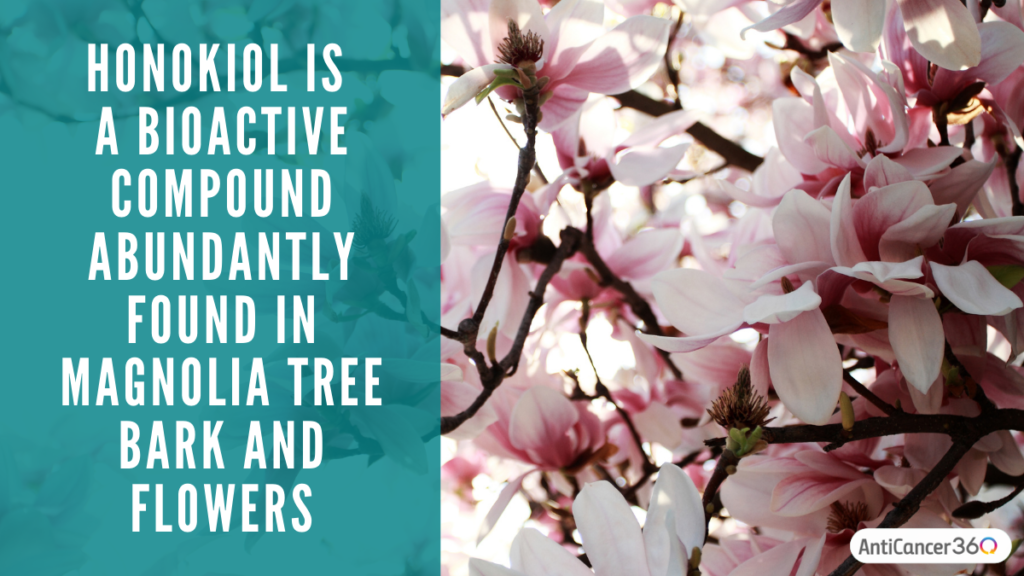
The potential benefit can often exceed the risks, depending on your condition. This is especially essential for aggressive and late-stage cancers.
Fortunately, there are many strategies that you can consider and incorporate in a way that doesn’t interfere with your oncologist’s treatments. And, nature has provided us with many anticancer substances that can help you fight cancer from every possible angle.
So in today’s post, we’ll show you the science behind honokiol’s anticancer potential and how you might consider integrating this substance into your plan.
What is Honokiol?
Magnolia tree bark and flower buds contain many biologically active compounds. The most active compounds are magnolol and honokiol. The oldest known book in Chinese medicine mentions magnolia for its calming effects. It’s been widely used in mental health, gum health, and most recently for its potential cancer-fighting effects [2].
One of the most intriguing aspects of magnolia extracts, including honokiol and magnolol, is their ability to penetrate the brain. For our protection, our bodies are very selective about the substances that can enter our brain.
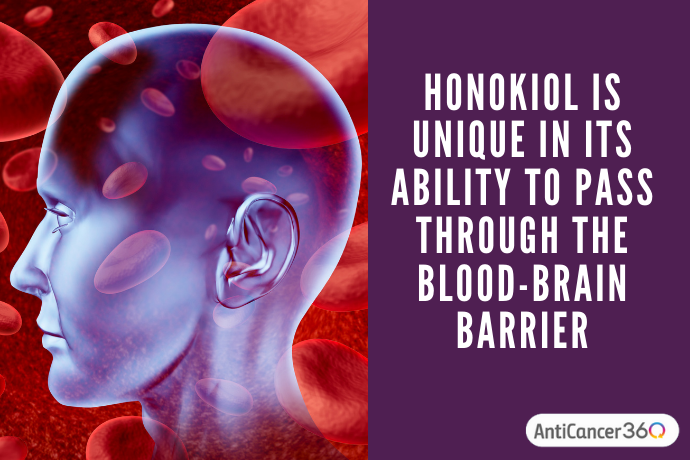
A highly discriminatory blood-brain barrier surrounds the blood vessels that carry circulating blood into the brain. Only certain substances can pass into the brain from the bloodstream. This mechanism is for our protection, but in some cases, the blood-brain barrier may be an obstacle to treatment [3].
Keep in mind that most studies of honokiol are preclinical research. This means that most scientific experiments with honokiol are done in a laboratory. Researchers study the effects of honokiol in animals or on human cancer cells in Petri dishes or test tubes in the lab.
Laboratory studies are performed to learn about anticancer effects to explore their potential application to humans. But first, they often use animal models, such as mice. It’s important to know that not all preclinical study results will show the same results in humans. But preclinical studies are still helpful, especially for identifying potential anticancer benefits and verifying safety in animals.
Almost every article written about honokiol’s anticancer potential concludes with the author stating that more research is needed. Clinical trials would help us learn more about the use of honokiol in humans.
However, our outlook is that you don’t always have time to wait for clinical trials when you’re facing challenging or advanced cancer. And, if your case is challenging, then our advice is to consider fighting your cancer from every angle, including the use of natural supplements. We recommend incorporating them in a safe way that doesn’t interfere with your other cancer treatments.
So, next, we’ll take a closer look at the potential anticancer effects of honokiol, starting with how this natural substance can influence cancer cell metabolism.
How to Starve Cancer with Honokiol: Cancer Metabolism Suppression
Cancer metabolism refers to the processes that cancer cells use to make energy from nutrients. One critical cancer-fighting strategy is to block or reduce the flow of nutrients to cancer cells. This includes sugar, fat, and protein.
The goal of this strategy is to weaken the cancer cells, making them more vulnerable to cancer-killing treatments. Fortunately, many natural substances show potential in blocking cancer’s metabolic processes, including honokiol.
Honokiol May Help Starve Cancer Cells by Blocking the Conversion of Sugar to Energy
Targeting the way cancer cells metabolize sugar can be a critical cancer-fighting strategy. This effectively starves cancer cells of the sugar they require to fuel their high growth rate.
Honokiol appears to target the mitochondria of cancer cells. Mitochondria are tiny but vital organs inside all animal and human cells. They operate as power generators for cells to function and grow.
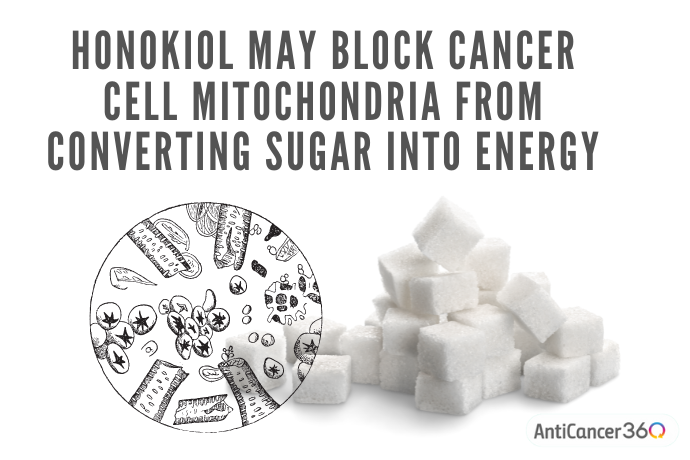
Within mitochondria, oxygen and sugar are used in various processes to produce molecular energy called ATP. Overall, ATP production depends on the mitochondrial processes of respiration (using oxygen) and breaking down sugar (glycolysis). So, a key strategy in cancer research is to develop treatments that mess with cancer cells’ ability to produce energy.
Research shows that honokiol directly binds to a specific site on cancer cell mitochondria. When honokiol binds to cancer cell mitochondria, it seems to disrupt the cells’ sugar metabolism. Human lung cancer cells were shown to have significantly reduced energy levels after being exposed to honokiol in a lab study [4].
When honokiol binds to mitochondria, the cell’s ability to convert sugar into energy is drastically reduced. When energy (ATP) production is halted, a sharp increase in free radicals occurs in the cell. These free radicals are also called receive oxygen species (ROS).
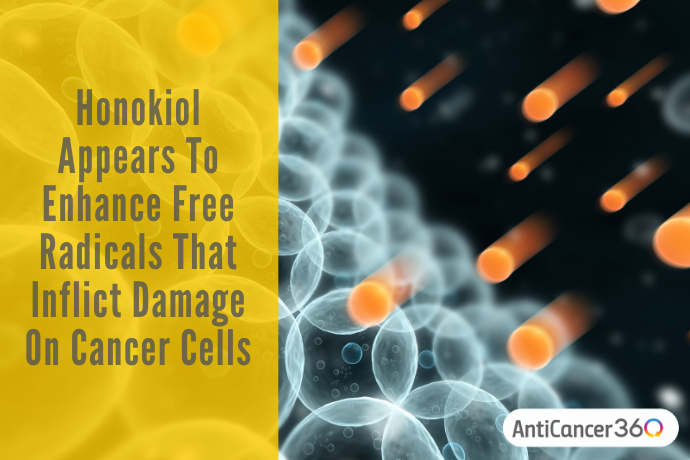
Honokiol has been shown to enhance ROS levels in human liver cancer [5], prostate cancer [6], and lung cancer cells [7]. ROS are known to contribute to cancer cell DNA damage and lead to cell death (apoptosis) [8].
Earlier in this blog post, we mentioned the unique ability of honokiol to penetrate brain tissue. In 2018, researchers modified honokiol into a form that they called mito-honokiol. In their experiments, mito-honokiol was more than 100-fold more potent than honokiol in its effects on blocking cancer cell mitochondria and stimulating ROS generation [9].
They found that treatment with mito-honokiol in mice blocked the spread (metastasis) of lung cancer cells to the brain. Their analysis showed that mito-honokiol enhanced cancer cell death and reduced the signaling pathways that lead to invasion and proliferation. They also noted that no side effects were observed in the mice [10].
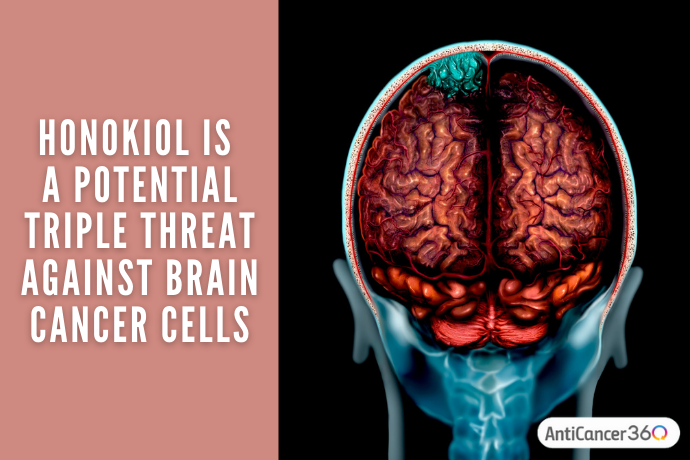
Since brain cancers (such as glioblastoma) and metastases can be tough to treat, honokiol has valuable potential. The blood-brain barrier is an obstacle that only a few conventional chemotherapy drugs can penetrate. With its ability to kill cancer cells, its non-toxic effects on healthy cells, and its ability to get into the brain, honokiol is a triple threat [11].
Now that we’ve explored honokiol’s effects on cancer cell mitochondria, we’ll take a closer look at honokiol’s other potential anticancer effects.
Honokiol May Enhance Tumor-Suppressing Autophagy
Cancer cells are quite resourceful. If their ability to convert sugar into energy is reduced, they’re able to use other energy sources, such as fat and protein. One mechanism for scavenging protein is known as autophagy. “Auto” means self, and “-phagy” means eat. So the literal meaning of autophagy is “self-eating.”
Autophagy is the body’s cell recycling system. This process breaks down old or damaged cells into fragments of proteins (amino acids) and cell membranes. Then the salvaged pieces are converted into energy or are used to construct new cells.
In some situations, autophagy can be a protective mechanism that may help stop tumor growth. The body’s healthy cells sometimes attempt to remove precancerous or cancerous cells through tumor-suppressing autophagy. Recent research shows that honokiol may play a role in enhancing this protective cell renewal process [12].

However, with cancer cells, autophagy can be a double-edged sword. Cancer cells can use tumor-promoting autophagy to their advantage. They can salvage pieces of cell proteins and fats and use them as energy sources. So, autophagy can sometimes promote tumor growth by preventing cancer cells from dying.
A 2018 lab study demonstrated that honokiol decreased the viability of human glioma (brain cancer cells). And more importantly, honokiol was shown to improve the cancer-killing effects of temozolomide in these cells [13]. Temozolomide (Temodar) is a chemotherapy drug that’s used to treat brain cancer.
Like other chemotherapy drugs, temozolomide has its downsides. It has challenging side effects and, unfortunately, tumors can develop resistance to it. However, this experiment included both glioma cells that were never exposed to temozolomide before and glioma cells verified as drug-resistant [14].
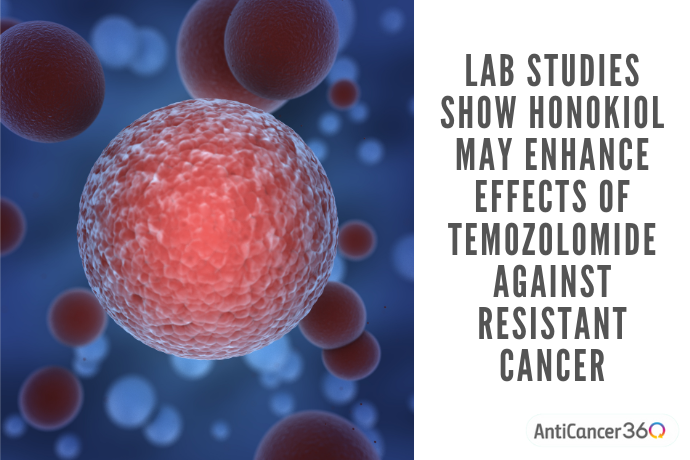
Interestingly, exposure to honokiol and temozolomide increased cell death (apoptosis) in drug-sensitive and drug-resistant glioma cells. The researchers analyzed the results and learned that honokiol exposure appeared to enhance tumor-suppressing autophagy. After the cancer cells were exposed to honokiol, the scientists detected increased markers of autophagy, including more cancer cell fragmentation [15].
Clinical studies are needed, but this lab study and others [16] clearly demonstrate the valuable potential of honokiol as a way to improve the results of standard therapy. A 2014 lab study showed that honokiol might be a helpful add-on tool to help fight cancers that have stopped responding to multiple chemotherapy drugs [17]. This phenomenon is known as multi-drug resistance, and it’s a major obstacle in conventional cancer therapy.
In this study, the addition of honokiol enhanced the effectiveness of paclitaxel against multi-drug resistant human cancer cells [18]. Paclitaxel (Taxol) is a popular chemotherapy drug that’s used for many cancer types. These researchers attributed honokiol’s synergism with paclitaxel to its influence on cancer cell mitochondria and cancer signaling pathways that lead to apoptosis (programmed cell death) [19].
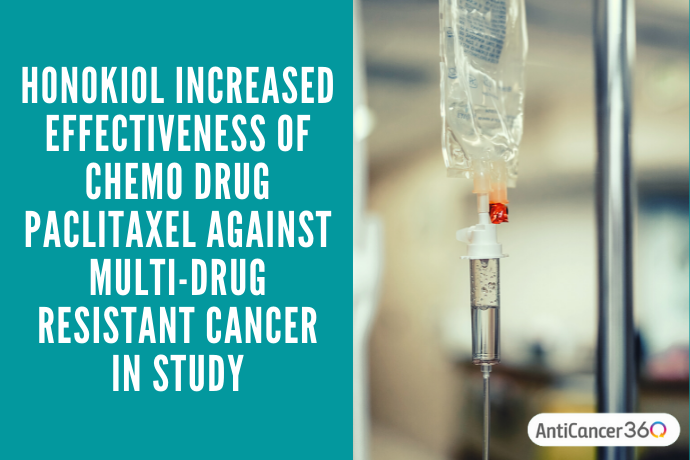
We know that honokiol possesses the special ability to pass through the blood-brain barrier. This feature, along with its multi-faceted, science-verified anticancer effects, makes honokiol an intriguing natural substance that you may want to add to your anticancer approach. Honokiol may be especially useful for people fighting brain cancers or any cancer that could spread to the brain.
In the next section, we’ll go over what you should know before starting a honokiol supplement.
How To Use Honokiol: Dosages, Side Effects, and Interactions
Dosage
Since there’s been limited clinical experience with honokiol, no standard dosage range or maximum dosage has been established.
Most magnolia extract products are standardized to 40% to 90% magnolol or honokiol components. For dosage guidance, follow the product’s label instructions or consult with your integrated healthcare professional.
Side Effects
Honokiol is generally considered safe, but it can possibly cause drowsiness or dizziness. So, it’s best if you avoid driving after taking honokiol until you become familiar with how it affects you.
Interactions with Drugs and Supplements
Honokiol could interact with other drugs, especially with chemotherapy and other drugs or supplements. This is not a comprehensive list of possible interactions, and some interactions may be unknown. Some examples include:
- Drugs or herbs that increase bleeding risk. Honokiol might increase the risk of bleeding. Blood-thinning effects of honokiol have been shown in animal studies. So, if you take blood-thinning medications (e.g., aspirin, Plavix, warfarin) or herbs (e.g., danshen, garlic, ginkgo), you should monitor yourself for signs of increased bleeding risk. Symptoms include bruising easily, bleeding gums, nosebleeds, or minor injuries that take a long time to stop bleeding.
- Drugs or herbs that cause drowsiness. Honokiol’s side effects may include drowsiness or dizziness. This side effect may be increased if you take sedative medications or herbs.

Because of the risk for drug interactions, you should consult with your healthcare provider before starting any supplements. It’s also best to share your updated medication and supplement list with your healthcare provider. Go over everything that you’re currently taking whenever a change to your treatment plan is being considered.
The Undeniable Anticancer Potential of Honokiol
Always discuss the risk-versus-benefit potential with your healthcare professional before starting any natural supplements, including honokiol.
Overall, you can see that there can be many potential benefits to adding a supplement like honokiol to your anticancer program to help you fight cancer from every direction.
Ultimately, when using an “Aggressive Integrative Approach” to cancer, the goal is to fight cancer from every possible direction. This approach includes integrating natural supplements into your anticancer strategy based on available evidence, despite limited human data… and doing it in a way that won’t interfere with your oncology treatments.
How are you approaching your cancer treatments? Are you taking any natural or dietary supplements? Have you tried a magnolia extract or another honokiol supplement? Are you making any other lifestyle changes that you feel are helping in your fight against cancer? Please let us know in the comments below!
Are You A Candidate For Our Program?
If you’d like to learn more about the AntiCancer360 approach and see if we can help you… either click here to schedule a free call to discuss your case in more detail, or watch our free online webinar to learn more about our approach.
Dr. Patricia Weiser is one of AntiCancer360’s consultant pharmacists, science advisors, and medical writers. Her expertise helps us create safe herbal and supplement combinations and avoid potential drug interactions.
Patricia is a graduate of the University of Pittsburgh and a licensed pharmacist. She has clinical experience in both community and hospital pharmacy. She is passionate about integrative and preventative care and strives to empower her patients to take an active role in their health.

